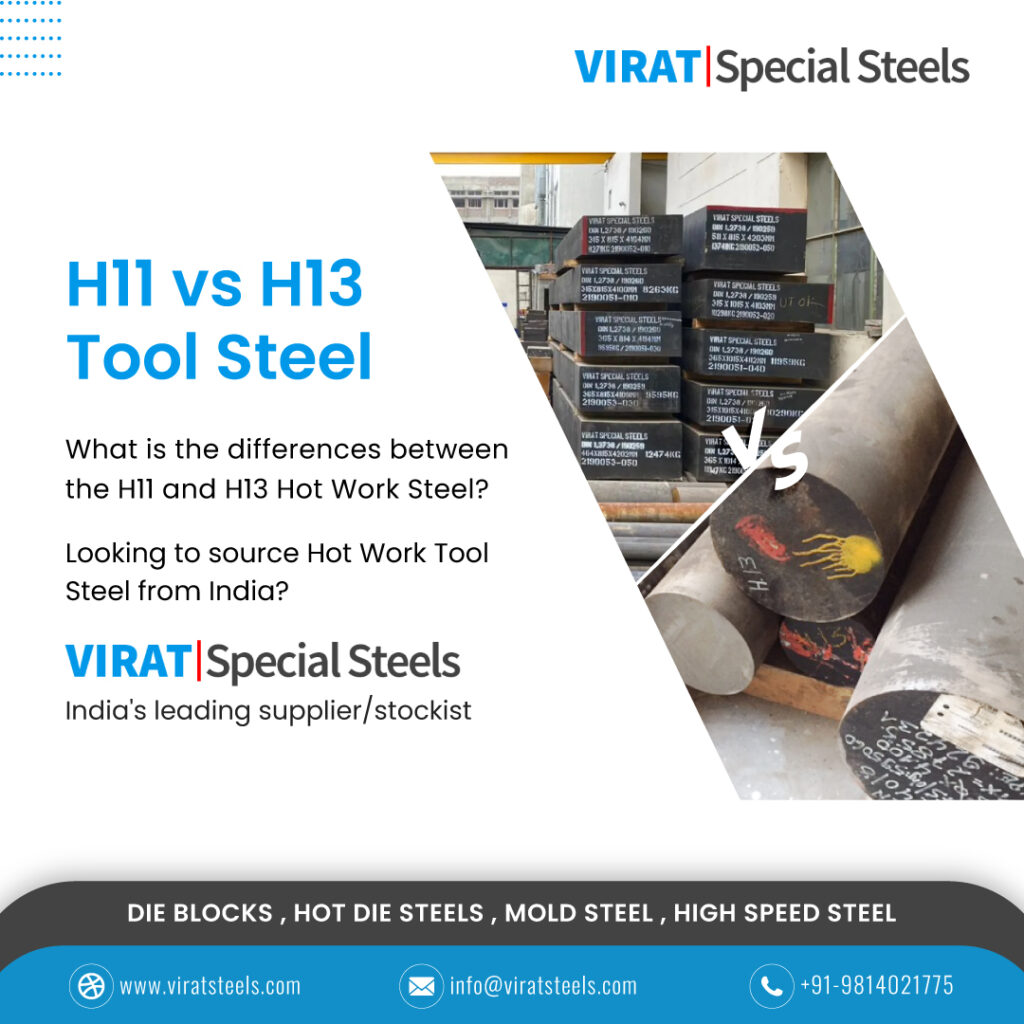What is the differences between the H11 and H13 Hot Work Steel?
If we compare between H11 and H13, H11 tool steel consists of less vanadium than the commonly used H13 hot work tool steel. This gives H11 steels the higher toughness, with some reduction in wear resistance and tamper resistance. H13 and H11 are both types of tool steels commonly used in the manufacturing and tooling industry, but they have different characteristics and applications.

Let’s compare H13 steel and H11 steel:
- Chemical Composition:
- H13 Steel: H13 is a hot work tool steel and is characterized by its high chromium content (around 5%) and molybdenum (1.4-1.75%). This composition gives it excellent heat resistance and wear resistance.
- H11 Steel: H11, on the other hand, is a hot work tool steel with a lower chromium content (around 4%) and no molybdenum. It has good toughness and heat resistance but is not as heat-resistant as H13.
- Heat Resistance:
- H13 Steel: H13 steel has excellent heat resistance, making it suitable for high-temperature applications such as die casting, forging, and extrusion.
- H11 Steel: H11 steel also offers good heat resistance, but it may not perform as well as H13 in extremely high-temperature environments.
- Toughness:
- H13 Steel: While H13 steel is tough, its primary strength lies in its heat resistance and wear resistance rather than toughness.
- H11 Steel: H11 steel is known for its toughness and is often used in applications where impact resistance is crucial, such as hammer forging and die casting.
- Applications:
- H13 Steel: H13 steel is commonly used in applications where high-temperature resistance and wear resistance are critical, including die casting dies, extrusion tools, and hot forging dies.
- H11 Steel: H11 steel is preferred for applications requiring good toughness and resistance to thermal fatigue, such as hammer and press forging, and certain types of die casting.
- Machinability:
- H13 Steel: H13 steel can be more challenging to machine due to its high hardness and heat resistance. Proper tooling and machining techniques are required.
- H11 Steel: H11 steel is generally easier to machine compared to H13, thanks to its lower hardness.
- Cost:
- H13 Steel: H13 steel is typically more expensive than H11 due to its superior heat resistance and wear resistance properties.
In summary, the choice between H13 and H11 steel depends on the specific requirements of your application. If you need high heat resistance and wear resistance, H13 may be the better choice. However, if toughness and resistance to thermal fatigue are more important, H11 could be the suitable option. Additionally, cost considerations can also influence the choice between these two tool steels.
APPLICATIONS:
Forging Dies, Punches / Dies for Extrusion on non ferrous alloys, Pressure Die Casting of Aluminium Alloys, Moulds for Thermo plastic polymer injection with high polishability. Die Inserts, Extrusion Press Tools, Forming Dies, Mandrels, Hot Shear Blades, Rolls for Hot Rolling Machines,Tools for Nuts,Screws, Bolts, Rivets, Fasteners, etc
Mode of Supply:
The Prime Supplier of Hot Work Steel in India is “VIRAT SPECIAL STEELS,” an ISO 9001:2008 certified company. Recognized globally as suppliers of quality steel they enjoy enviable affiliations with the leading producers of special steels and heavy engineering across the world. So their advice and solutions should prove invaluable in the choice of steel for different applications – such as guidance on whether H13 or H11 is better suited for your process.
Learn more:
https://www.viratsteels.com/hot-work-steel.html
https://www.viratsteels.com/h13.html
https://www.viratsteels.com/h11.html
Email us: info@viratsteels.com
Call Us Now: +91-9814021775






